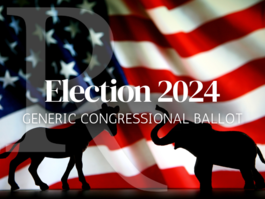How We Did, and Why We Did It
After Tuesday’s midterm elections, mainstream media critics and the so-called “polling analyst” community believes they’ve found a new use for Generic Ballot question results. Their attempted quantifications concerning House-only specific seat changes and popular vote tabulations are both interesting and theoretical.
Generic Ballot questions typically ask about a general propensity to vote for one party or the other if a national election was held today. Rasmussen Report adds a generic ballot question to its daily likely voter survey in the months running up to both midterm and presidential elections. Our question wording runs as follows: "If the elections for Congress were held today, would you vote for the Republican candidate or for the Democratic candidate?"
Note there is no distinction here between the U.S. House of Representatives and the U.S. Senate. House and Senate party preference are both combined into the concept of “Congress.” Note also that unlike separate specific candidate favorability questions (Clinton or Trump?), no individual names are listed. This underlies the concept of a simple generic preference.
Polling-focused writers and analysts have been exploring linkage and correlation effects between generic ballot question results and changes in both the House of Representatives and popular vote totals for some time. Rasmussen Reports has not and does not make specific separate predictions of House, Senate or popular vote results, leaving that to others.
In the last midterm election in 2014, the party turnout numbers from various exit poll databases were 36% Republican, 35% Democrat and 28% Independent. While we expected more Democratic enthusiasm this time around, the Republicans were also energized by things like the Kavanaugh hearing and illegal immigration. We also sensed once again a silent Trump vote that most pollsters, not Rasmussen Reports, missed in 2016 and appeared to be missing again this year. In addition, our monthly analysis of the roughly 10,000 interviews we collect was showing fairly even numbers between those identifying as Republicans and Democrats.
As a result, Rasmussen Reports projected the turnout to be 33% GOP, 34% Democrat and 33% Other in its Generic Ballot projection. This was less Republican and more independent than the previous midterm election.
That said, Tuesday’s results were revealing. Democrats picked up an apparently low number of House seats compared to recent prior first-term midterms. Republicans picked up a relatively high number of Senate seats compared to prior first-term midterms going back to the Kennedy administration. Taken together this preliminary data points to a better turnout and outcome for Republicans than other generic ballot pollsters predicted.
Was our R+1 net final generic ballot score (with a +/- 2 margin of error) reasonable? We believe it was, but we’ll look at all the data in the coming weeks to see if any adjustments to our national likely voters party weighting is appropriate.
Rasmussen Reports is a media company specializing in the collection, publication and distribution of public opinion information.
We conduct public opinion polls on a variety of topics to inform our audience on events in the news and other topics of interest. To ensure editorial control and independence, we pay for the polls ourselves and generate revenue through the sale of subscriptions, sponsorships, and advertising. Nightly polling on politics, business and lifestyle topics provides the content to update the Rasmussen Reports web site many times each day. If it's in the news, it's in our polls. Additionally, the data drives a daily update newsletter and various media outlets across the country.
Some information, including the Rasmussen Reports daily Presidential Tracking Poll and commentaries are available for free to the general public. Subscriptions are available for $4.95 a month or 34.95 a year that provide subscribers with exclusive access to more than 20 stories per week on upcoming elections, consumer confidence, and issues that affect us all. For those who are really into the numbers, Platinum Members can review demographic crosstabs and a full history of our data.
To learn more about our methodology, click here.



